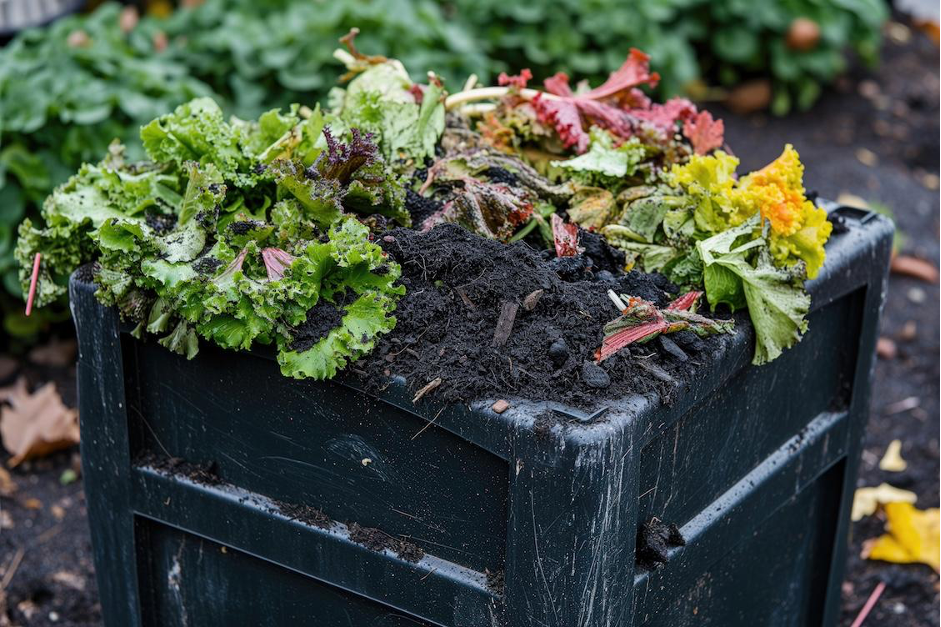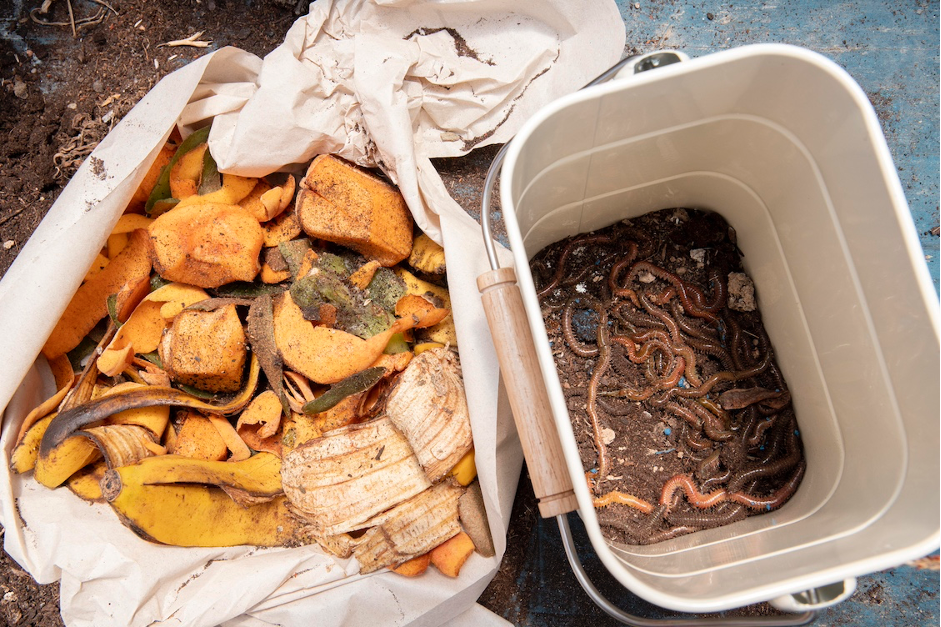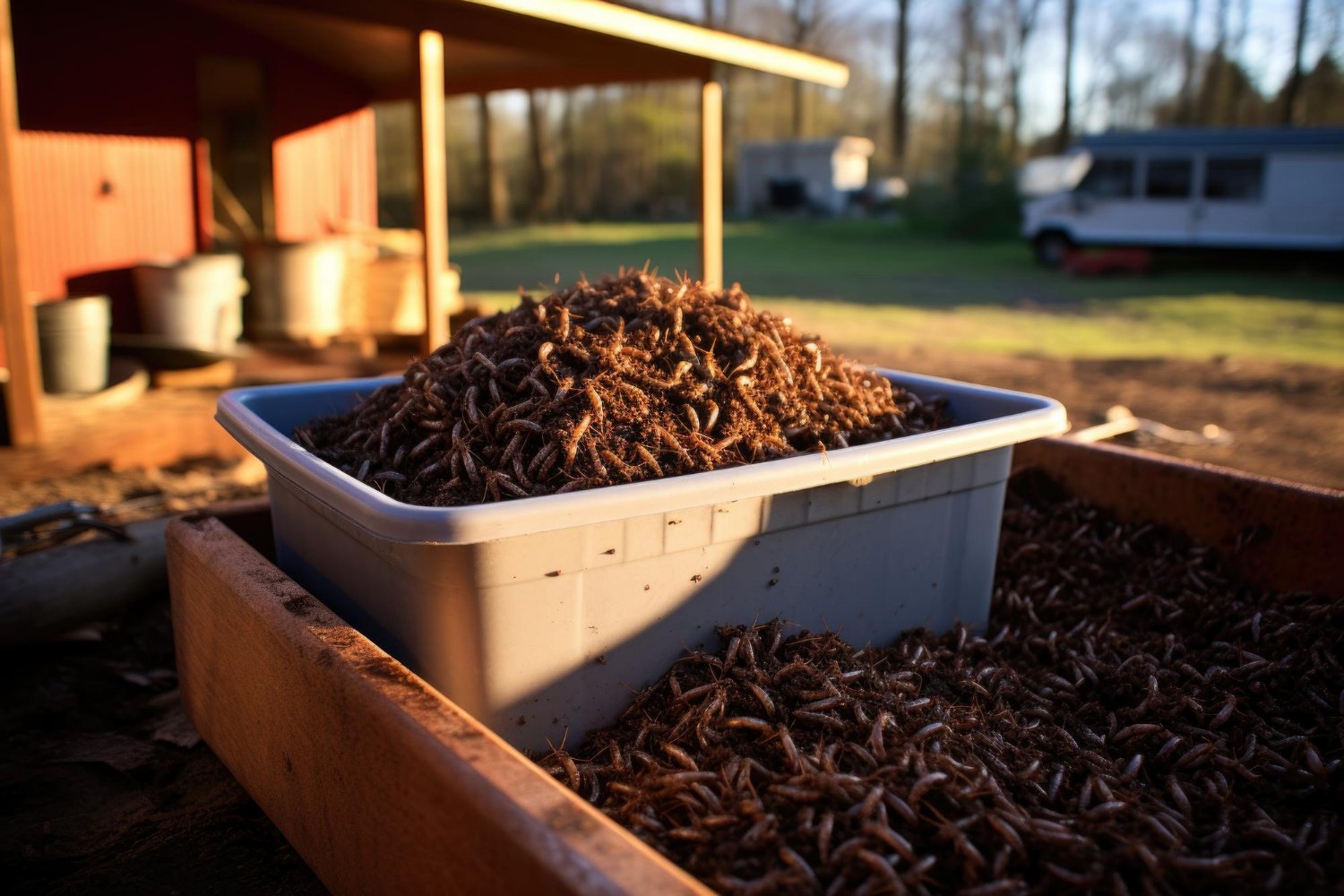 When something goes wrong with your worm composting bin, this Troubleshooting Guide can help! Bookmark this page and return whenever you think something is amiss with your worm bin. Uncle Jim’s Worm Farm is the #1 supplier of composting worms in the USA. We’ve been growing and selling worms for more than 40 years. Click on the problem to see solutions.
When something goes wrong with your worm composting bin, this Troubleshooting Guide can help! Bookmark this page and return whenever you think something is amiss with your worm bin. Uncle Jim’s Worm Farm is the #1 supplier of composting worms in the USA. We’ve been growing and selling worms for more than 40 years. Click on the problem to see solutions.
Troubleshooting Odor
Too Much Food Left Over
Insects & Fruit Flies
Furry Pests
Escapes
Too Hot or Too Cold
No Babies
Troubleshooting Odor
In most cases, your nose alerts you to worm bin problems. Vermicomposting bins should have an earthy smell. Bad odors emanating from your worm bin mean something is wrong. Regular “hot” composting without added worms is usually malodorous. Worm composting includes making a loving home for thousands of worms. Worm bins break down the organic more quickly than hot composters. Therefore, the worm bin should not stink.
HTML does not have odor tags. Therefore, we cannot give you direct olfactory insight into types of worm bin smells. Suffice it to say that if the worm bin smells yucky, something is amiss.
To troubleshoot foul odors:
- Is the odor coming from rotting food? Dig around and give it a sniff. If there is a large amount of undigested organic matter, take some out. You might be over-feeding the worms. Too much food replaces air in the bin, creating an anaerobic environment. Vermicomposting is aerobic, requiring oxygen. You might be feeding the wrong types of foods. For example, oily foods, meats, and dairy products will make your bin smell.
- Is the bin too wet? Squeeze some bedding in your hand. The bedding should have the consistency of a wrung-out sponge. To bring down the moisture level, sop up puddles with paper, paper towels, or cloth. Or add small rolls of newspaper throughout the bin. Make sure the drainage holes are not clogged. If the bin has a spigot, open it to drain the water. Don’t let rainwater in — put on a lid and place the bin under shelter. You can add more bedding such as pure peat moss, coconut coir, or shredded black and white newspaper. Stir gently. If you cannot address high moisture quickly, you may need to transplant the worms to a new bin and start over,
- Is the bin too dry? Pick up a handful of bedding and squeeze it. Does it feel like a wrung-out sponge? If it feels too dry, judiciously add water. Ideally, dechlorinate the water first by leaving it out overnight. A clean watering can that has never contained chemicals is perfect, or just pour on a little at a time. Stir gently. To keep the bin moist, keep the lid on and consider adding a worm bin cover.
- Is the pH off? The bin should have a neutral pH of approximately 7. It’s difficult to tell the pH by looking at it. An inexpensive pH probe will help. Limestone makes an acidic bin more alkaline (raises the pH). Adding more acidic or alkaline foods also changes the pH in the bin.
Too Much Food Left Over
Do you see a lot of food in the bin? You may be feeding the worms too much at once.
- bury the food so it’s easy for the worms to find
- feed them an amount they can handle every 2 to 3 days. Feedings from 1 to 2 weeks ago should be completely gone.
Insects & Fruit Flies
Most of the time, insects in the bin are nothing to worry about. Many insects help break down the food faster. Burying the food scraps will discourage pests. However:
- If the bin is indoors, watch out bad house guests such as cockroaches. You might have to move composting outdoors until the cockroaches have been eliminated.
- Centipedes can eat worms. They should be removed and stomped on outdoors.
- A few mites will make their home in the worm bin; large amounts of mites are not healthy. Red mites are parasites to worms. They love moist environments. Therefore, make sure your worm bin is not too wet (see “Odor” above”)
- Fruit flies are annoying indoors. Set traps near the bin and places where they congregate.
- If an ant colony or other insect family tries moving in, remove the lid for a day or two. They might not like the light.
Furry Pests
Raccoons, rodents, and other local furry pests might stop by your bin for a bite to eat. This is not a major problem unless they are doing damage. For example, hungry raccoons will eat nearly anything. They might resort to raiding or knocking over your bin to get at food scraps and worms.
Most of the time, pests are attracted by the strong odors of oils, meat, fish, and dairy products. These foods should never go in a worm bin.
Bury scraps to cut down on odor.
Keep a lid on the bin. Hold it down with bungee cords, rocks, or bricks.
If you are desperate, move the bin to a safer location.
Escapes
Worms that are comfy and cozy will stay put. Uncomfortable worms may start trying to climb out. If you see more than a few escapees, consider this:
- Something might be wrong in the bin – follow this troubleshooting guide.
- Worms don’t like getting moved around or put into a vehicle.
- Adult worms may try to flee when babies hatch. Force them to stay, and the population will balance itself out. Or, move some of the adults to a new bin.
- If they are climbing up the bin walls and this bothers you, shine a light on the bin. Remove the lid. They will dig down in minutes because they don’t like the brightness.
Too Hot or Too Cold
The ideal operating temperature for a Red Worm bin is between 57 degrees Fahrenheit and approximately in the 80’s or 90’s. Worms will start to die under 40 degrees. Too hot, and they start to cook. At the change of seasons, consult our articles on preparing worms for the Winter and the Summer.
No Babies
Happy worms will reproduce. Take good care of them and they will lay egg-filled cocoons. If the temperature is right, they hatch in 3 to 4 weeks. If you have not seen baby worms in the bin, be patient. They will come along when conditions are right. Note: the problem is not gender imbalance. Worms are hermaphrodites, so they have both male and female traits.
Conclusion
Take care of your worms, and your worms will take care of you. They will munch contentedly on your vegetable and fruit scraps, coffee grounds, and tea bags. In return, the worms will create valuable fertilizer, and cut back on trash. Just open this guide when something goes amiss in your worm bin. Uncle Jim’s Worm Farm is here to help! Got questions? Connect with us on social media. Our blog has valuable information for getting started and sustaining your worm bin. We offer Red Worms for composting; European Night Crawlers for fishing, aerating the soil, and composting; mealworms for pet food and science experiments; and a large selection of convenient composters.









16 thoughts on “Worm Composting Bin Troubleshooting Guide”
How do I get the free worms?
It is rude to ask for things for free when they obviously work really hard on this free information for us all.
Well, I’d like to give it another run. I’ve started up a compost a couple times now and you always deliver great worms that do well up until about the time summer rolls in. Winter isn’t a problem here in So.Cal. but Summer often hits triple digits and combine that with fresh compost excellerating and heating up and every time I get thousands of worms across the inside of my garage like a bunch of dry sticks from their attempt to escape. I’ve tried keeping ice packs in my compost but it’s a mess changing out every day and I keep them in the garage because it’s atleast cooler than outside in the sun. Any suggestions during the hot summer heat that will keep these guys alive during that time?
One last question, can the european nightcrawlers co-reside with the red compost worms in the same bins? (I always appreciate having some fishing bait when needed…lol)
Had a good start on raising worms in two 5 gallon buckets (holes in bottom of top bucket and in lid of top bucket. Drain in lower part of bottom bucket. Over-watered or overfed and killed the entire crop.
Next effort will be to use a moisture meter to control moisture content and Coconut Coco Coir Fiber to create a better worm bed.
Questions/issues: Tried to bring worm farm inside when too hot or too cold outside. Significant problem with fruit flies. Can I use an old tee shirt over the top of the top bucket to stop the flies from getting into the house and upsetting my wife?
How do I control the smell. I have used homemade dry worm food to try to minimize odor. I think that I got the bedding too wet or fed the worms too much and the awful smell came from dead worms.
How much dry worm food. should I use in the 5 gallon top bucket?
I now have a 3 way soil meter.https://www.amazon.com/gp/product/B07BRDV7L8/ref=oh_aui_detailpage_o00_s00?ie=UTF8&psc=1
What level of moisture should I keep the worm bedding at?
Are Red Worms the best for fishing worms?
How do I get rid of some of the white mites that are increasing in numbers? Worm bins are otherwise healthy by general appearances.
I am doing indoor worm composting.
I noticed last week that I started to have small critters which look like baby roaches. Do you have any suggestions on what I can do?
Do you supply in India?
My problem is that my worm bed is at a pH level of 8. I can’t find information on lowering the levels, just raising them. Any suggestions?
My bin attracted mites and the Troubleshooting tips in the Vermi-Hut online manual said their presence indicates the worm system is too acidic and/or possibly dehydrated. (Mine is too wet in places!)
They suggested raising the pH (make it more alkaline) with oyster shell powder or crushed eggshells on top of the working trays.
WormFarmGuru suggests adding calcium carbonate such as crushed eggshells or agricultural lime to neutralize acidity and increase the pH.
I also emailed Uncle Jim’s and they also suggest well crushed up eggshells.
You might try adding some cardboard to your bin to help lower the PH level. You can shred it or tear it by hand & then mix it into your bin. Worms will eventually eat the cardboard. I also make my own buffer for those times that I over do feedings. I keep a mix of equal parts of
“Oyster Shell” which is a good source of grit & also a pH buffer. Also good source of calcium.
“Kelp Meal” which provides trace minerals.
“Diatomaceous Earth” which is a good grit source & also adds some trace minerals. It can also be good for bug control if kept dry. You just need to be careful to not breathe this in as it’s not good for your lungs; so, be careful when using. Doesn’t seem to bother my worms tho.
I just sprinkle this mixture into my bin & mix it through the castings especially when feeding questionable foods for the first time or when my PH balance is off.
1. Neem cake: https://amzn.to/2QtPALv (excellent for bug control)
I have a pagoda-style worm hut and I can’t seem to get a more than a few of my worms to migrate up to the next level. I have some food stuff, cardboard, dried leaves covered by coir from a hanging basket. I haven’t put food on the first level in many months. I thought they would head up, out of the casting, but they are still hanging down there are “commuting,” I guess. What should I be doing to make the second floor more hospitable?
I have recently found hard white crumbly chunks in my worm bin…almost a salt consistency. I cannot figure out what it is, it has spread throughout the entire bin. Worms still seem healthy. Not sure if it is something I should be concerned about? I have searched online and cannot find anyone discussing this issue. Do you have any advice? Thanks!
My three tiered worm bin is happy…though discovered mites in the lowest bin. Also using the method of not disturbing them..adding scraps etc then covering with newspaper strips. Has been too wet, add cardboard? what else? thank you!
I keep my worm tubs outside and this year all of them have lots of sow bugs (pill bugs). Is this a problem for the worms? I often add leaf litter to the tubs and this probably introduces insects. I always pick out the earwigs as they look like they could eat worm eggs. Last summer and fall I noticed hard clumps of soil when I sifted out the tubs to remove the soil and castings. When I broke the clumps apart I found small white larvae. Again, is this a problem for the worms?
Is there any use for the liquid that the worms produce?
Hi Matt,
This liquid that is produced is called leachate. The resulting dark water is tempting. It looks like a great source of fertilizer for your plants. Unfortunately, this leachate often contains a bad mixture of microorganisms. Left in the dark without the worms and bedding, the bad organisms reproduce. Leachate might also contain too much salt for your houseplants. Thus, worm bin leachate is a poor fertilizer.
Uncle Jim’s Worm Farm